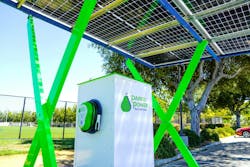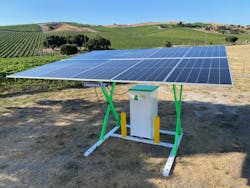Microgrids On-Grid, Off-Grid, Big and Small for EV Charging
Wineries, cities, ports and other entities anxious to skip utility interconnection delays, go green and save money are turning to microgrids for charging electric vehicles (EV).
These EV adopters are often facing two-year interconnection delays, government regulations requiring them to lower their carbon footprint and the potential for high utility demand charges.
Interconnection challenges slow EV charging projects
In a recent report from Xendee and Endeavor Business Media, about 75% of survey respondents said that electric grid limitations are a significant roadblock to the rollout of EV charging infrastructure for commercial electric vehicles. Project costs, permitting, construction and supply chain challenges were also named as roadblocks. Nearly 80% of respondents listed microgrids fueled by distributed energy resources as the top game-changing technology to stimulate the transition from internal combustion engines to EVs and electric fleets.
Recent projects back up the report’s conclusions, highlighting the interconnection challenges facing EV enthusiasts and possible microgrid solutions.
For example, Prologis Mobility, which provides charging-as-a-service, and Performance Team, a Maersk company that operates over 140 EVs across the U.S., are deploying a microgrid near the Ports of Los Angeles and Long Beach that will charge up to 96 electric trucks simultaneously.
EVs to meet California’s truck requirements
Facing a two-year utility interconnection delay and California’s requirements to stop selling diesel trucks and transition to electric drayage trucks – which generally transport containers and bulk freight – by 2035 and electric heavy-duty trucks by 2045, the ports are investing in charging infrastructure to help fuel their 20,000 trucks.
The microgrid includes 2.75 MW of fuel-flexible, hydrogen-ready linear generators paired with 18 MWh of batteries that can provide up to 9 MW of charging capacity.
Henrik Holland, global head of mobility for Prologis, said in an email that the project uses Mainspring linear generators, which allow for the use of hydrogen.
Natural gas will be used in the short term, he said. And the project will connect to the Los Angeles Department of Water and Power (LADWP) once it gains interconnection.
Hydrogen could power the microgrid in the future
The project isn’t using hydrogen right now because the infrastructure in California isn’t ready to deliver enough hydrogen or provide distribution.
“We are actively investigating the supply of hydrogen and when it becomes more accessible, we will consider its integration for this and future projects,” Holland said. Once the project gains utility interconnection, the microgrid will serve as backup if the grid goes down, he said. Initially, the microgrid won’t provide grid services, but Prologis may collaborate with the LADWP in the future to provide those services.
Powering the Future: M&A Opportunities in Evolving Energy Sector
Free and New White Paper: Download Now
Holland declined to reveal the total cost of the microgrid. It was financed mostly by Prologis, with some grant money provided by the California Energy Commission’s EnergIIZE program and the LADWP, he said.
For this project, Prologis Mobility will use a charging-as-a-service model, which involves no upfront costs to the customer and includes design and construction, energy procurement, hardware, operations monitoring, proprietary software solutions and maintenance.
A microgrid to power a California city’s electric truck
A smaller microgrid project from Paired Power for the city of Campbell, California’s Public Works Service Center takes a different approach to avoiding interconnection delays and charging the service center’s first EV – a Ford F-150 Lightning Pro.
Paired Power will provide solar electricity to the Ford Lightning with the company’s pop-up solar canopy, along with Level 2 EV chargers and management software, both from EV Connect. The solar power will be combined with available grid power and battery storage, providing resilience and reducing the city’s dependence on the grid.
The microgrid includes a 4.6-kW bifacial solar array plus 42 kWh of energy storage.
The project uses the site’s available electricity, said Tom McCalmont, Paired Power’s CEO.
Making the most of available grid electricity
“A lot of lighting poles in the parking lots have already been replaced with LED lights so they have extra capacity in the circuit already,” he said. “This helps if it’s cloudy.” By using available electrical capacity, the city won’t have to do an electrical upgrade or dig a trench across the parking lot, he added.
A resiliency grant from Silicon Valley Clean Energy will pay for the installation.
Paired Power has begun offering PairFleet, a microgrid that is custom designed for larger installations.
“Let’s say we’re building 50 chargers and we put in a 100-kW solar array. We would add six to eight of our battery enclosures so we have enough capacity to store energy and deliver at night,” McCalmont said. With this type of system, a customer could charge service vehicles at night and employee vehicles during the day.
Lowering demand charges and saving money
The PairFleet system can offset demand spikes. Paired Power installs a meter to monitor demand spikes and inject power from the microgrid into the chargers, reducing the cost of utility demand charges, he said.
Paired Power now has 90 installations, including a commercial building in South Carolina and the U.S. Embassy in Jamaica. Right now, the company is building a PairFleet microgrid system for a customer in San Diego, California, that will include 24 charging stations, McCalmont said.
A winery’s electric tractor needs a microgrid
Paired Power is also working with Carr Winery in Santa Barbara, California, to build an off-grid microgrid with a 30-kW solar array and charger that would supply electricity to an electric tractor.
More and more microgrids, such as those deployed by Paired Power and Prologis Mobility, are providing power to charging stations that otherwise wouldn’t be up and running for years.
“They have the need today, not two years from now,” said McCalmont. “The market is enormous.”
About the Author
Lisa Cohn
Contributing Editor
I focus on the West Coast and Midwest. Email me at [email protected]
I’ve been writing about energy for more than 20 years, and my stories have appeared in EnergyBiz, SNL Financial, Mother Earth News, Natural Home Magazine, Horizon Air Magazine, Oregon Business, Open Spaces, the Portland Tribune, The Oregonian, Renewable Energy World, Windpower Monthly and other publications. I’m also a former stringer for the Platts/McGraw-Hill energy publications. I began my career covering energy and environment for The Cape Cod Times, where Elisa Wood also was a reporter. I’ve received numerous writing awards from national, regional and local organizations, including Pacific Northwest Writers Association, Willamette Writers, Associated Oregon Industries, and the Voice of Youth Advocates. I first became interested in energy as a student at Wesleyan University, Middletown, Connecticut, where I helped design and build a solar house.
Twitter: @LisaECohn
Linkedin: LisaEllenCohn
Facebook: Energy Efficiency Markets



